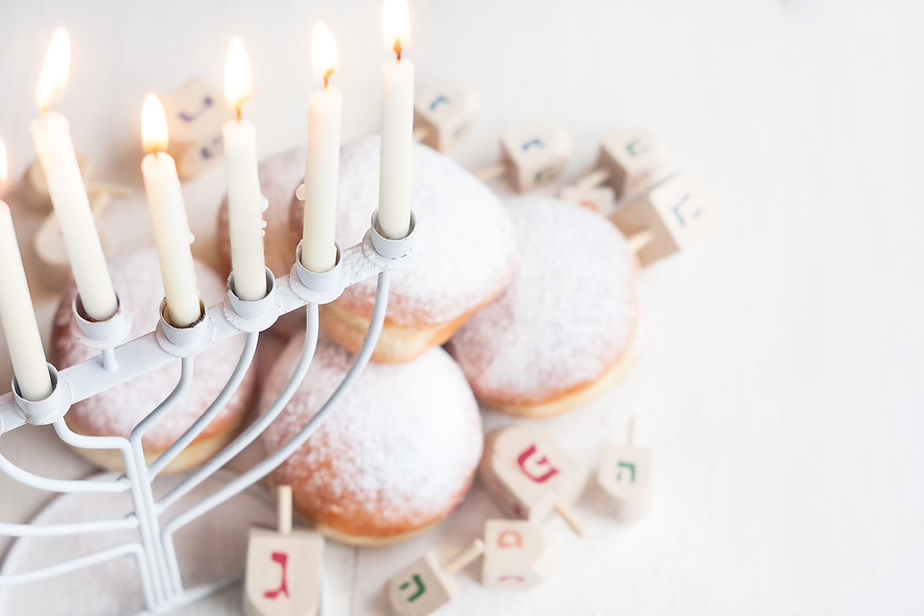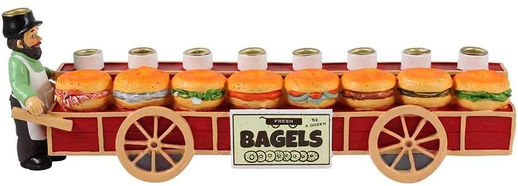
HANUKKAH
The Festival of Lights
Hanukkah in 2024 will begin in the evening of Wednesday, December 25 and will last till sundown, Thursday, January 2, 2025. (Eight night of candle lighting is on Wednesday, January 1, 2025.)
However you spell the Festival of Lights (Hanukah, Hanukkah, Chanukah, etc.), this Jewish holiday has grown increasingly popular over the centuries. Based on the military victory of Jews who resisted the rule of the Syrian Greek ruler Antiochus Epiphanes IV, it has taken on spiritual aspects that resonate even more strongly in today’s world. Metaphorically, it represents the triumph of light over darkness. It has also evolved to represent the importance of religious freedom.
Although it is a festival in the Jewish calendar, work is permitted like on any ordinary day. The only obligation is to light the candles each evening and say the blessing over them. Hanukkah is an eight-day festival that starts on the 25th of the Jewish month of Kislev, and almost always takes place in December. The actual dates on the Gregorian calendar will change, however, as the Jewish calendar is a modified lunar one.
After the death of Alexander the Great, his vast empire was divided into three parts. At first, Judea was under the jurisdiction of the Hellenistic (or Syrian) Greeks. When Antiochus IV Ephiphanes demanded that Jews in his kingdom bow to him as a “Greek God” and give up circumcision and other Jewish rituals, a Jewish family, the Hasmoneans, started a resistance movement. This rebellion was first led by Mattathias, a Jewish priest, and his five sons. After his death, his son Judah Maccabee (“the Hammer”) and his brothers continued the fight along with other Jewish groups in Judea who refused to remain under Antiochus’ harsh rule. After two years they successfully drove the Syrian Greek soldiers out of Jerusalem. Discovering that the Temple had been desecrated, the rebels cleansed the site and lit the menorah (oil lamp)--a candelabrum with seven branches--which was to remain burning all of the time.
According to the Talmud, a miracle occurred. Although there was only enough untainted olive oil to last one day, the menorah stayed lit for eight days. After that time, a fresh supply of oil was found.
After more years of battle, the family and its partners drove the Greek Syrians out of Judea entirely and The Hasmonean Dynasty was established; it remained in power for over a century. Judea then came under Roman rule.
There is an alternative understanding as to why Hanukkah lasts for eight days. The holiday is believed to be a belated celebration of Sukkot, which takes place in the fall. Many argue that the battles that were taking place at that time prevented the Jews from observing that festival.

Candle Lighting Rules
The first night (erev Hanukkah), we light the candle farthest to the right with the shammas (helper) candle. On the second night, we light the two candles farthest to the right. However, we light these candles in the order left to right. On the third night, we light the three candles farthest…..etc. etc. until all of the candles are lit. On Friday night (erev Shabbat), we light our menorah before we light our Shabbat candles, and on Saturday night, we light our menorah after Havdalah. Tradition says that our Hanukkah lights should be placed where people outside the home can see them.
What do You Think?
Two thousand years ago, the Rabbis Hillel and Shammai disagreed about how many candles to start with on the menorah. Shammai argued that one should begin with the eight lit wicks placed in the oil menorah (oil lamps were used at the time) and then one should decrease the number over the festival period. Hillel disagreed, saying that we should begin with one and increase our “light” as the holiday progressed.
Blessings
Blessed are You, our God, Creator of time and space, who enriches our lives with holiness, commanding us to kinkle the Chanukkah lights.
Baruch atah adonai eloheinu melech ha'olam asher kid'shanu b'mitzvotav v'tzivanu l'hadlik neir shel Chanukkah.
Blessed are You, our God, Creator of time and space, who performs miracles for our ancestors, in the days of long ago and in this time.
Baruch atah adonai eloheinu melech ha'olam she'asah nisim la'avoteinu bayamim haheim baz'man hazeh.
As we light the candles, we chant the two blessings above. On the first night, we also recite the Shehecheyanu blessing:
Blessed are You, Adonai our God, Sovereign of all, who has kept us alive, sustained us, and brought us to this season.
Baruch atah, Adonai Eloheinu, Melech haolam, shehecheyanu, v'kiy'manu, v'higiyanu laz'man hazeh.
Customs
Although Hanukkah is especially popular among children, as gift giving has become the tradition in recent decades, adults primarily keep up the customs such as eating certain symbolic foods (see Recipes) and lighting the menorah (hanukiah in Hebrew). There are a wide “looks” to menorahs. But what is essential is a shammas, or guardian candle, which “stands” higher than the other eight. We have seen traditional brass menorahs, menorahs adorned with crystals, ceramic and china ones, and menorahs in the shape of animals, railroad trains, a table setting and buildings.
For a sampling of widely different types of contemporary lamps, click here.
Need a great menorah (hanukiah) for a kid or for the kid in "you," then check out this great compilation of online stores where you can purchase one.
Another tradition is to spin the dreidel (sevivon in Hebrew)—a four-sided top. It is usually made of plastic or wood, but can also be made of ceramic or metal. Each side bears a Hebrew letter which spells out the theme of the holiday, which is "Nes Gadol Hayah Sham. A Great Miracle Happened There."


Rules of the game: A small “prize” is put into the “pot” with amounts of the prize given to each participant to start (raisins, candy, nuts, chocolate gelt/coins, pennies, etc.). Each participant takes his/her/their turn spinning the dreidel. The dreidel will land on one of the four Hebrew letters. Depending on the letter, a different “action” follows.
-
Land on “nun” and nothing happens.
-
Land on “gimmel” and you take the entire pot.
-
Land on “hey” and you take half of the pot.
-
Land on “shin” and you give a predetermined amount back into the pot.
Whenever the pot is empty, each participant must contribute a set amount. Any player that cannot contribute after landing on a “shin” or after a fellow player lands on a “gimmel” loses.
As with every Jewish holiday, Jews from different parts of the world may add their own twists/variations. In this article from the online JTA, we learn about Eid Al Bnat, the Festival of Daughters (Judeo-Arabic), also pronounced Chag HaBanot in Hebrew, which is celebrated by women and girls from North Africa’s Jewish communities.
Recipes
Almost every Jewish cookbook features a chapter or two on Hanukkah delicacies—from the ever-present latke in all of its forms (potato, sweet potato, zucchini, beet, cheese, etc.) to sufganiyot (jelly doughnuts) and more. Frying in oil is the main “theme” in most Hanukkah recipes in order to remind us of the oil that lasted eight days. Here is a recipe for beet latkes, courtesy of JTA, another recipe for fried pickle latkes, and below a listing of just a few of the Jewish cookbooks that offer Hanukah recipes.
-
California Kosher, A collection of recipes from the Women’s League of Adat Ari El Synagogue
-
Jewish Holiday Cookbook by Joan Nathan
-
Children's Jewish Holiday Kitchen: A Cookbook with 70 Fun Recipes for You and Your Kids by Joan Nathan
-
Kosher Delicious: Great Recipes for Living. Edited by Diana Kastenbaum & Penny Brenner.
-
Tastes of Jewish Tradition by Jody Hirsh, Idy Goodman, Aggie Goldenholz and Susan Roth
NOTE: Many of our synagogues and Jewish organizations also sell cookbooks.

Fried Pickle Latkes
Readings for Children
Hanukkah remains a powerful inspiration for children’s stories. Listed below are some favorite “oldies.”
-
Heshel and the Hanukah Goblins by Eric Kimmel
-
How Do Dinosaurs Say Happy Chanukah? by Jane Yolen
-
Where is Baby’s Dreidel? by Karen Katz (board book)
-
All-of-a-King Family Hanukkah by Emily Jenkins
-
Sammy Spider’s First Hanukkah by Sylvia A. Rouss
-
The Trees of the Dancing Goats by Patricia Polacco
-
Gracie’s Night: A Hanukkah Story by Lynn Taylor Gordon
-
Hanukkah Bear by Eric Kimmel
-
Latke, the Lucky Dog by Ellen Fisher
-
Eight Wild Nights by Brian Cleary
Also, eight new Hanukkah-focused books titles can be found with their descriptions here at JTA.org.
Due to the proximity of Hanukhah and Christmas, there are also a growing number of books for children where members of the family are Jewish and Christian.
-
Eight Candles and a Tree by Simone Bloom Nathan.
-
December’s Gift: An Interfaith Holiday Story by Ashley Smith-Santos
A complete listing of Hanukkah books can also be found here at PJ Library’s website.





